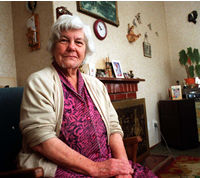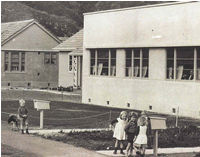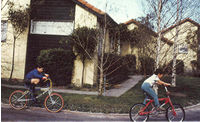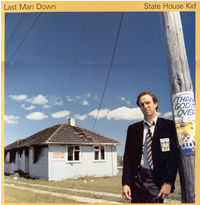Building Families
Young family outside new state house, Naenae
Nell Fleury inside her state house in 1999
![]() Moving
into new state houses in the Hutt Valley
Moving
into new state houses in the Hutt Valley
State house kids at play, c.1945
State house kids at play, 1978
Cover of State House Kid album
Listen to extract from title track (mp3, 1.5mb)
![]() Suburban plans of the future (1946)
Suburban plans of the future (1946)
Opening of Auckland state house modified for a larger family
'We had a marvellous life for the kids.'
Glad Carrick, Naenae resident, 1940s
Glad's heartfelt comment captures an essential aim of state housing: to provide suburban homes for families, a place where children could grow up in safe and spacious surroundings, away from the dangers of the inner city. This guided state housing policy from the beginning. The houses built under Premier Richard Seddon's workers' dwellings scheme from 1905 were targeted at working families, invariably nuclear families: two parents with children. Successive governments continued the practice, believing the nuclear family to be the 'foundation of the nation', a foundation that required the buttressing of the state to remain grounded and true.
Keys to the Front Door: Arrival Stories
One such family was the Redpaths. At the age of eleven Shirley Redpath, her mum, dad and two younger siblings shifted to a new state house in 1940s Naenae. Almost 60 years later she could still vividly remember the big day:
My first impression of NaeNae as we drove up the main street, Seddon Street, was one of shock and disbelief, hardly a tree, shrub, plant, lawn in sight, no footpaths even! What had we had come to? The car slowly pulled up at No. 61 and we all stepped out onto slightly muddy ground. [On] first sight … the house appeared welcoming, modern, attractive, with a large windowed sun porch. Leaving our shoes at the front door we excitedly ran through the new house, footsteps thumping and echoing on the bare wooden floors. We flung open doors to explore the rooms. Light streamed through the curtain-less windows, giving a feeling of lightness and airiness.
Shirley's story evocatively captures both the material and the emotional journey of coming to a new (and unseen) home: trying to make sense of an unfamiliar neighbourhood; uncertainty about what to expect; and, above all, the excitement of arrival and exploration. Since then, hundreds of thousands of other state housing tenants have taken similar journeys, albeit arriving via a myriad of different routes.
Failing Families
But not all tenants and their families have experienced happy and secure times growing up in state houses. Behind curtained windows and locked doors some children and women have experienced abuse – both physical and emotional – from family members and friends. Others, especially teenagers, have found suburban family life boring and have searched for excitement in the city, especially at weekends.
Neither have all tenants experienced a sense of exhilaration on moving into their state houses. One woman told a committee investigating Maori women's housing in the early 1990s that when she went to look at her new family home she found:
dirty nappies in the laundry, broken panes in the sliding door, holes punched in the ceiling where the light was, sockets hanging out, pyjamas stuffed down the toilet, and [the Housing Corporation] said, 'you can have it for a couple of weeks rent free'. I said, 'you come down here and look at it, have you been through it?' and he said, 'yes, but I'm not in your position, am I?'
Changing Families
From the 1970s governments recognised that fewer people were living in nuclear families. State housing policy changed to cater for the needs of those who lived in extended, blended and sole-parent families. In the 1940s the average state house family comprised two parents and children, but in the 1990s – reflecting trends in wider society – the typical state house family consisted of a sole parent and children.
Large families also posed a challenge for designers and policy-makers. The first Labour government's two-sizes-fits all approach to state housing, with most houses having either two or three bedrooms, was fine for families of up to five but became a squeeze for larger households. The government argued it was uneconomic to build state houses for bigger families because few could afford the higher rent.
Instead, the government bought large houses in older suburbs that it could rent out more cheaply. By 1942 it acknowledged that the demand for these houses was far outstripping supply, and began constructing five- and six-bedroom houses in the larger cities. These included a row of six dwellings built in Point Chevalier, Auckland, in 1945 and allocated to families of between nine and thirteen children.
From now on a small proportion of new state houses were constructed for big families. Among them were the Parker families of Titahi Bay (Porirua) and Porirua East; Peter and Dick Parker were brothers who boasted families of eleven and nine children respectively. In 1963 a journalist spoke to their wives, Margaret and Mary Parker, about their lives. Surveying the dozen bottles of milk her family consumed each day, Margaret confessed that her food bills were high, but noted that things were made easier by the £33 she received in government family allowances each month. This paid the rent, with something left over for the electricity bill and clothing. The family allowance was also pivotal in Mary's household: ‘quite frankly, I couldn't do without it'.
The Parker families were Pakeha. Since the 1980s, higher fertility rates and lower relative incomes have meant that most big families living in state houses have been Maori or Pacific Island people. In 2000 Housing New Zealand began extending traditional three-bedroom state houses in an effort to meet the requirement for increased space that was accentuated by the larger average size of Maori and Pacific families. Porirua's eight-member Onasai family benefited from this policy. When in 2001 the semi-detached unit next door became vacant, Housing New Zealand removed the dividing wall and refurbished the interior, turning the Onasais' three-bedroom home into a six-bedroom one.
Next: Making Ends Meet >







